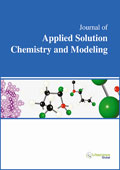jascm
Abstract : To the Mathematical Theory of the Temkin Adsorption Model
 To the Mathematical Theory of the Temkin Adsorption Model - Pages 6-12 To the Mathematical Theory of the Temkin Adsorption Model - Pages 6-12Michael Vigdorowitsch, Liudmila E. Tsygankova and Pavel N. Bernatsky DOI: https://doi.org/10.6000/1929-5030.2020.09.02 Published: 04 April 2020 |
Abstract: This study expands the mathematical theory of the Temkin adsorption model and demonstrates the way experimental data are to be additionally treated. A functional complement property of the Temkin isotherm has been studied as a particular case of the common theory of asymptotic complement. This property is shown to give rise to various analytical strategies to be employed for processing or interpretation of the experimental results, e.g. to perform mapping of data obtained in experiments onto a conjugated part of the true isotherm, to judge if presupposed energetic heterogeneity type of the surface really takes place, etc. Experimental data for adsorption of carbon monoxide on gold and of sodium oleate on steel with and without a magnetite coating have been extensively analysed. |
Abstract : The Existence of Two Types of Colloidal Solutions of Molecules Fullerene C60
|
|
Abstract: The last thirty years scientists carried out an active search of universal parameter of solvent C60 for predicting the solubility of fullerenes. However, this parameter was not found up to these days. In this paper it has been found an explanation of the impossibility of detection of such parameter. In present paper the features of the solubility of fullerene C60 molecules in nonpolar solvents have been studied. The molecule state diagram of the fullerene С60 molecules in solution at temperatures 265÷308 К and pressure range 1÷100 МPа, indicating the existence field of β- and γ-modifications, has been constructed. Moreover, it has been shown that in the solutions of fullerenes C60 in the γ-state the solubility decreases with a rise in temperature since the chemical activity of fullerene molecule increases. For this reason during extraction procedure the temperature rise causes the value of extraction rate to increase, but solubility – to decrease, i.e. to diminish the concentration of fullerenes molecules in the solvent volume. Keywords: Fullerene C60 molecule, molecule diagram, colloidal solution, solubility isobar, solutions classification. |
Abstract : Adsorption of Rare Earth Elements (REEs) onto Activated Carbon Modified with Potassium Permanganate (KMnO4)
|
|
Abstract: The adsorption capacity of activated carbon modified with potassium permanganate(KMnO4) for rare earth elements (REEs) from aqueous solution was investigated. The modified activated carbon was characterized by SEM (scanning electron microscopy), FT-IR (Fourier transform infrared spectrometer), and N2 adsorption-desorption tests. Adsorption experiments from aqueous solutions containing known amounts of some REEs (i.e. La, Lu, Yb, Eu, Y, Sc) onto the carbon were explored in a batch system.The amount of REEsadsorbed at different pH values, initial concentrations, and contact times were determined by inductively coupled plasma-atomic emission spectrometry (ICP-AES) in order to determine the optimum conditions for REEs adsorption. The adsorption of REEs on the activated carbon was well fitted by the Langmuir isothermal adsorption equation. The rates of adsorption were found to conform to pseudo-second order kinetic. These results presentthe modified activated carbonas an efficient adsorbent for REEs, hence creating new avenues for the treatment of industrial waste waters including pollutants. It is very significant information from the viewpoint of environmental protection. Keyword: Adsorption, modified activated carbon, rare earth elements (REEs), adsorption isotherms, kinetics. |
Abstract : Degradation of Toxic Indigo Carmine Dye by Electrosynthesized Ferrate (VI)
|
Abstract: Response surface methodology was applied for optimizing indigo carmine (IC) dye removal by electrochemically produced ferrate (VI). Box-Behnken design was employed in this study, and design parameters were pH, Fe (VI) dose and initial dye concentration (Co). R2 and adjusted R2 values were very high that indicated very good accuracy for the employed model. Optimum operational conditions were: 4.08-7.69 for pH, 24-118.83 mg/L for Fe (VI) dose and 60.68-99.13 mg/L for complete removal of IC. Produced by electrochemical method Ferrate (VI) provides high effectiveness for IC dye-containing synthetic wastewater. Keyword: Adsorption, modified activated carbon, rare earth elements (REEs), adsorption isotherms, kinetics. |





















